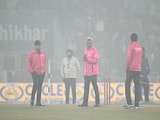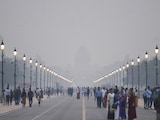Despite a two-year-old warning from the Indian Council of Medical Research (ICMR) about the risks of calcium carbide guns, these unlicensed and improvised "toy guns" continued to be sold across Madhya Pradesh this Diwali, leading to nearly 300 cases of eye injuries reported from hospitals in and around Bhopal.
The medical body ICMR had warned two years ago that such devices can cause serious and permanent vision loss. Doctors said at least 30 patients have lost sight in one eye, while several others remain under treatment for corneal burns and chemical injuries.
The 2023 study titled 'Vision-threatening ocular injury secondary to calcium carbide gun use in Indian children and young adults: A case series' explains the chemical reaction that calcium carbide, when mixed with water, produces acetylene gas, which explodes on ignition. The resulting blast and spray of hot calcium hydroxide can cause severe chemical and thermal burns to the eye.
"Public awareness should be raised about the potential hazards of carbide gun use. Restrictions should be imposed on the widespread unlicensed sale of calcium carbide guns and raw materials - at least for children," the study notes.
The study takes on five young male case studies aged between 10 and 23 years from Khargone district who suffered severe eye injuries while using locally made or street-bought carbide guns.
The victims sustained monocular injuries ranging from partial loss of vision (6/36) to complete loss of light perception. Two patients required amniotic-membrane transplantation to treat deep chemical burns, yet corneal opacity and poor vision persisted. According to the paper, the injuries occurred because of improper handling, poor design quality, and the unpredictable functioning of the guns.
A Preventable Tragedy
The ICMR report concluded that ocular injuries from carbide guns are largely preventable through public education, regulation of raw material sales, and quality control standards for any such devices.
The devices, originally designed as "scare guns" to drive animals from farms, are now used during festivals as low-cost substitutes for firecrackers.
Despite this advisory, street vendors and online sellers across Bhopal and nearby towns continued offering these guns for as little as Rs 100 to Rs 300. Videos on social media platforms teach users to build their own devices using PVC pipes, calcium carbide lumps, and gas lighters.
Parents interviewed by the researchers said the guns could be bought without adults' knowledge and were marketed as inexpensive toys. None of the examined guns in the study had safety features or warning labels.
The study also noted that treating these chemical and thermal injuries places a heavy financial and emotional burden on families in resource-limited settings.
Unregulated Sales Continued
Overlooking the warning, carbide guns remained openly available in markets across Madhya Pradesh this festive season. Vendors reportedly sold them for a few hundred rupees as "safer" alternatives to firecrackers. Authorities said that while information from the ICMR study was shared with state departments, no statewide prohibition was issued before Diwali 2025.
Delayed Response
Only after hundreds of injuries were reported, the Bhopal district administration issued a prohibitory order banning the manufacture, storage, sale, and use of carbide guns. The circular, referencing the ICMR study, stated that these unregulated devices "generate excessive noise and pose a threat to public safety." The order also restricts illegally modified firecrackers that employ explosive mixtures in metal or PVC pipes. Health officials said public-awareness drives are being planned to discourage the use of such devices.















